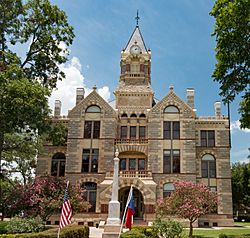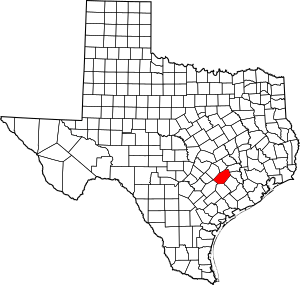Fayette County, Texas facts for kids
Quick facts for kids
Fayette County
|
|
|---|---|

The current Fayette County Courthouse in La Grange was finished in 1891. The Romanesque Revival style building uses four types of native Texas stone to detail the exterior.
|
|

Location within the U.S. state of Texas
|
|
 Texas's location within the U.S. |
|
| Country | |
| State | |
| Founded | 1837 |
| Named for | Marquis de la Fayette |
| Seat | La Grange |
| Largest city | La Grange |
| Area | |
| • Total | 960 sq mi (2,500 km2) |
| • Land | 950 sq mi (2,500 km2) |
| • Water | 9.8 sq mi (25 km2) 1.0% |
| Population
(2020)
|
|
| • Total | 24,435 |
| • Density | 25.45/sq mi (9.83/km2) |
| Time zone | UTC−6 (Central) |
| • Summer (DST) | UTC−5 (CDT) |
| Congressional district | 10th |
Fayette County is a county in the state of Texas. In 2020, about 24,435 people lived there. The main city and county seat is La Grange. Fayette County was created in 1837.
Contents
History of Fayette County
Fayette County was formed in 1837. It was made from parts of Bastrop and Colorado counties. The county is named after the Marquis de la Fayette. He was a French nobleman and a hero of the American Revolutionary War.
One important early resident was Joel Walter Robison. He fought in the Texas Revolution. He also served in the Texas government. Many historic places in Fayette County are listed on the National Register of Historic Places.
Geography and Location
Fayette County covers about 960 square miles. Most of this area is land. Only a small part, about 9.8 square miles, is water.
Neighboring Counties
Fayette County shares borders with several other counties. These are:
- Lee County (north)
- Washington County (northeast)
- Austin County (east)
- Colorado County (southeast)
- Lavaca County (south)
- Gonzales County (southwest)
- Caldwell County (west)
- Bastrop County (northwest)
People and Population
| Historical population | |||
|---|---|---|---|
| Census | Pop. | %± | |
| 1850 | 3,756 | — | |
| 1860 | 11,604 | 208.9% | |
| 1870 | 16,863 | 45.3% | |
| 1880 | 27,996 | 66.0% | |
| 1890 | 31,481 | 12.4% | |
| 1900 | 36,542 | 16.1% | |
| 1910 | 29,796 | −18.5% | |
| 1920 | 29,965 | 0.6% | |
| 1930 | 30,708 | 2.5% | |
| 1940 | 29,246 | −4.8% | |
| 1950 | 24,176 | −17.3% | |
| 1960 | 20,384 | −15.7% | |
| 1970 | 17,650 | −13.4% | |
| 1980 | 18,832 | 6.7% | |
| 1990 | 20,095 | 6.7% | |
| 2000 | 21,804 | 8.5% | |
| 2010 | 24,554 | 12.6% | |
| 2020 | 24,435 | −0.5% | |
| U.S. Decennial Census 1850–2010 2010 2020 |
|||
The population of Fayette County has changed over time. In 1850, there were about 3,756 people. By 1900, the population grew to over 36,000. In recent years, the population has been around 24,000 people.
Most people in Fayette County are White. There are also groups of African American, Native American, and Asian people. A growing number of people are of Hispanic or Latino background.
In 2000, the average age in the county was 43 years old. About 23% of the population was under 18. About 22% were 65 or older. The average income for a family was about $43,156 per year.
Transportation in Fayette County
Airport
Fayette County has its own airport. It is called the Fayette Regional Air Center. It is located near La Grange.
Main Highways
Several important highways pass through Fayette County. These roads help people travel and move goods.
 Interstate 10
Interstate 10 U.S. Highway 77
U.S. Highway 77 U.S. Highway 90
U.S. Highway 90 U.S. Highway 290
U.S. Highway 290 State Highway 71
State Highway 71 State Highway 95
State Highway 95 State Highway 159
State Highway 159 State Highway 237
State Highway 237
Media and News
Fayette County has local news sources. These include newspapers and radio stations.
Newspapers
- Fayette County Record
- Schulenburg Sticker
- Flatonia Argus
Radio Stations
- KVLG/KBUK
- KTIMe
Communities in Fayette County
Fayette County has several towns and cities. It also has many smaller communities.
Cities
- Carmine
- Fayetteville
- La Grange (This is the county seat)
- Schulenburg
Towns
Unincorporated Communities
These are smaller places that are not officially cities or towns.
- Ammannsville
- Armstrong
- Bethany
- Bridge Valley
- Buckner's Creek
- Burnham's Crossing
- Cedar
- Center Grove
- Cistern
- Colony
- Dubina
- Ellinger
- Elm Grove
- Engle
- Floy
- Ford's Prairie
- Franke
- Freyburg
- Halsted
- High Hill
- Holman
- Hostyn
- Indian Creek
- Ingram's Prairie
- Joiner
- Kirtley
- Kocicina
- Ledbetter
- Lena
- Leevan
- Lewis Settlement
- Live Oak Hill
- Lyons
- Manton Spring
- Marly
- Mecklenburg
- Middle Creek
- Miller's Station
- Moravan
- Mullins Prairie
- Nassau
- Navidad
- Nechanitz
- O'Quinn
- Oldenburg
- Orizaba
- Oso
- Park
- Pecan
- Pin Oak
- Pine Springs
- Plum
- Praha (formerly Mulberry)
- Prairie Valley
- Rabbs Prairie
- Rek Hill
- Rocky Ridge
- Ross Prairie
- Roznov
- Rutersville
- St. John
- Scott
- Sedan
- Stellar
- Swiss Alp
- Tamberg
- Toledo
- Waldeck
- Walhalla
- Warda
- Warrenton
- Wendt
- West Point
- Willow Springs
- Winchester
- Winedale
- Wood's Fort
- Wursten
- Zapalac
Ghost Towns
These are places that used to be communities but are now mostly empty.
- Biegel
- Black Jack Springs
- Bluff
- Gay Hill
- Haw Creek
- Stella
Education in Fayette County
Students in Fayette County attend schools in several different school districts.
- Fayetteville Independent School District
- Flatonia Independent School District
- Giddings Independent School District
- La Grange Independent School District
- Round Top-Carmine Independent School District
- Schulenburg Independent School District
- Smithville Independent School District
- Weimar Independent School District
For college, most of Fayette County is part of the Blinn Junior College District. Some parts of the county are also served by Austin Community College.
See also
 In Spanish: Condado de Fayette (Texas) para niños
In Spanish: Condado de Fayette (Texas) para niños

